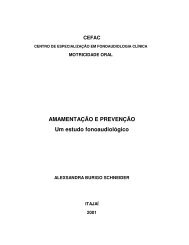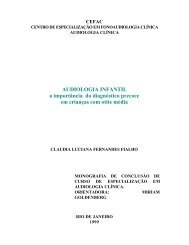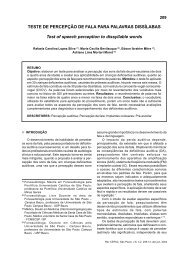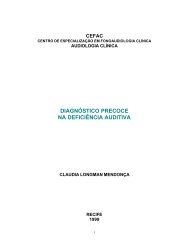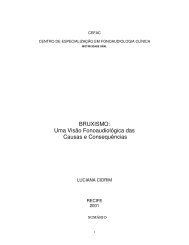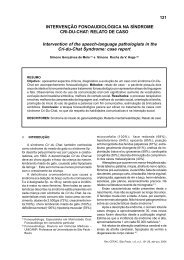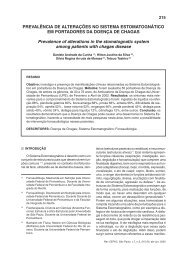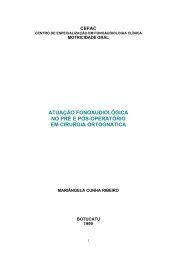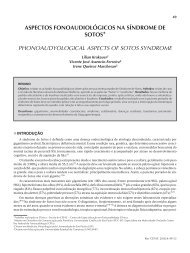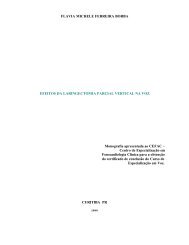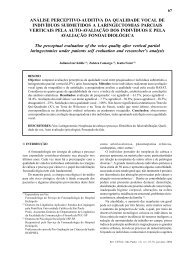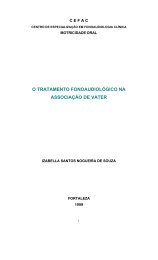a eficcia da prtese auditiva no controle do zumbido - CEFAC
a eficcia da prtese auditiva no controle do zumbido - CEFAC
a eficcia da prtese auditiva no controle do zumbido - CEFAC
You also want an ePaper? Increase the reach of your titles
YUMPU automatically turns print PDFs into web optimized ePapers that Google loves.
O CONTROLE DO ZUMBIDO ATRAVÉS DO USO DE PRÓTESES<br />
AUDITIVAS RETRO-AURICULARES*<br />
Tinnitus control through the use of ear hearing aids<br />
GISELE MUNHÓES DOS SANTOS FERRARI (1)<br />
Especializan<strong>da</strong> em Audiologia Clínica e Saúde <strong>do</strong> Trabalha<strong>do</strong>r pelo <strong>CEFAC</strong>-<br />
Centro de Especialização em Fo<strong>no</strong>audiologia Clínica<br />
Graduação em Fo<strong>no</strong>audiologia - Facul<strong>da</strong>de de Medicina <strong>da</strong> Universi<strong>da</strong>de São<br />
Paulo<br />
Endereço para correspondência<br />
Rua Tenente Negrão, 140 cj 91<br />
Itaim Bibi São Paulo – SP CEP:04530-030<br />
Tel 31676556 E-mail: giselemsf@hotmail.com<br />
TANIT GANZ SANCHEZ (2)<br />
Professora Colabora<strong>do</strong>ra Médica <strong>da</strong> Facul<strong>da</strong>de de Medicina <strong>da</strong> Universi<strong>da</strong>de<br />
de São Paulo e Médica Assistente Doutora <strong>da</strong> Divisão de Clínica<br />
Otorri<strong>no</strong>laringológica <strong>do</strong> Hospital <strong>da</strong>s Clínicas <strong>da</strong> Facul<strong>da</strong>de de Medicina <strong>da</strong><br />
Universi<strong>da</strong>de de São Paulo.<br />
ALICE PENNA DE AZEVEDO BERNARDI (3)<br />
Mestre em Saúde Pública pela Facul<strong>da</strong>de de Saúde Pública <strong>da</strong> Universi<strong>da</strong>de<br />
de São Paulo.<br />
*Instituição de Origem:<br />
FACULDADE DE MEDICINA DA UNIVERSIDADE DE SÃO PAULO<br />
Título com até 40 caracteres: Zumbi<strong>do</strong> e próteses retro auriculares<br />
1
RESUMO<br />
Objetivo: avaliar a resposta <strong>do</strong> zumbi<strong>do</strong> à prótese <strong>auditiva</strong> retro-auricular com<br />
molde aberto. Méto<strong>do</strong>s: 31 pacientes com zumbi<strong>do</strong> e per<strong>da</strong> <strong>auditiva</strong> foram<br />
orienta<strong>do</strong>s a testar próteses retro-auriculares com moldes abertos,<br />
bilateralmente, se possível. Entretanto, 16 optaram por a<strong>da</strong>ptação mo<strong>no</strong>aural.<br />
Resulta<strong>do</strong>s: Houve melhora satisfatória <strong>do</strong> zumbi<strong>do</strong> em 71% e <strong>da</strong> audição em<br />
87% <strong>do</strong>s casos. Moldes abertos mostraram-se significantemente melhores para<br />
o <strong>controle</strong> <strong>do</strong> zumbi<strong>do</strong>. Não houve diferença estatística entre as a<strong>da</strong>ptações<br />
mo<strong>no</strong> e binaurais. Conclusão: a prótese retro-auricular com molde aberto foi<br />
eficaz para o <strong>controle</strong> <strong>do</strong> zumbi<strong>do</strong>.<br />
DESCRITORES: Zumbi<strong>do</strong>; Implantes cocleares; Per<strong>da</strong> <strong>auditiva</strong>; Ajuste de<br />
prótese; Audiometria de resposta evoca<strong>da</strong>; Potenciais evoca<strong>do</strong>s auditivos;<br />
Limiar auditivo; Audição<br />
2
ABSTRACT<br />
Purpose: Evaluate tinnitus response to behind the ear hearing aids with open<br />
molds. Methods: 31 patients with tinnitus complaint and hearing loss<br />
underwent a test using BTE devices with open mold in both ears whenever<br />
possible. However, 16 opted for unilateral use. Results: Tinnitus diminished in<br />
71% and hearing loss improved in 87% of the patients. Open molds were<br />
significantly better for tinnitus control. There was <strong>no</strong> significant difference<br />
between unilateral and bilateral a<strong>da</strong>ptation. Conclusion: BTE devices with<br />
open molds were efficient for tinnitus control.<br />
KEYWORDS: Tinnitus; Cochlear implants; Hearing loss; Prosthesis fitting;<br />
Audiometry, evoked response; Evoked potentials, auditory; Auditory threshold;<br />
Hearing<br />
3
INTRODUÇÃO<br />
O zumbi<strong>do</strong> é uma queixa otológica muito comum, chegan<strong>do</strong> a atingir<br />
15% <strong>da</strong> população <strong>do</strong>s Esta<strong>do</strong>s Uni<strong>do</strong>s. Em 15% a 25% <strong>do</strong>s casos, o zumbi<strong>do</strong><br />
apresenta interferência importante na quali<strong>da</strong>de de vi<strong>da</strong>, poden<strong>do</strong> afetar o<br />
so<strong>no</strong>, a concentração, o equilíbrio emocional e até as ativi<strong>da</strong>des sociais (1-2). É<br />
freqüentemente descrito pela percepção de um ou mais sons nas orelhas ou na<br />
cabeça sem que haja presença de estímulo exter<strong>no</strong> correspondente (3) .<br />
Dentre as diversas causas <strong>do</strong> zumbi<strong>do</strong>, que dificilmente podem ser<br />
isola<strong>da</strong>s, estão as <strong>do</strong>enças otológicas, alterações cardiovasculares, <strong>do</strong>enças<br />
metabólicas, neurológicas, psiquiátricas, fatores o<strong>do</strong>ntológicos e possivelmente<br />
a ingestão de drogas, cafeína, nicotina e álcool (4) .<br />
Cerca de 85% a 96% <strong>do</strong>s pacientes com zumbi<strong>do</strong>, apresenta também<br />
algum grau de per<strong>da</strong> <strong>auditiva</strong> associa<strong>da</strong> (5-9) . Ambos os sintomas podem<br />
apresentar repercussão importante na vi<strong>da</strong> diária <strong>do</strong> paciente. O incômo<strong>do</strong><br />
causa<strong>do</strong> pelo zumbi<strong>do</strong>, por ser essencialmente subjetivo, pode ser<br />
razoavelmente descrito pela <strong>no</strong>ta de 0 a 10 <strong>da</strong> escala análogo-visual (EAV).<br />
Este mesmo tipo de escala pode ser utiliza<strong>da</strong> para representar o incômo<strong>do</strong><br />
causa<strong>do</strong> pela per<strong>da</strong> de audição.<br />
Na prática clínica, observou-se que os pacientes que apresentam<br />
zumbi<strong>do</strong> severo acompanha<strong>do</strong> de per<strong>da</strong> <strong>auditiva</strong> clinicamente importante,<br />
apresentam maior dificul<strong>da</strong>de <strong>no</strong> <strong>controle</strong> <strong>do</strong> zumbi<strong>do</strong> com o uso de<br />
medicamentos sintomáticos, independente <strong>da</strong> etiologia envolvi<strong>da</strong> (10) .<br />
Há muito tempo a prótese <strong>auditiva</strong> vem sen<strong>do</strong> utiliza<strong>da</strong> <strong>no</strong> senti<strong>do</strong> de<br />
minimizar os efeitos <strong>da</strong> deficiência <strong>auditiva</strong> (11) .<br />
4
Entretanto, a a<strong>da</strong>ptação <strong>da</strong> prótese <strong>auditiva</strong> somente com o intuito de<br />
melhorar a audição não costuma promover melhora satisfatória <strong>do</strong> zumbi<strong>do</strong> em<br />
pacientes com ambas as queixas (12) . Isto porque é comum a queixa de piora<br />
<strong>do</strong> zumbi<strong>do</strong> com a oclusão <strong>do</strong> meato acústico exter<strong>no</strong> pelo molde <strong>da</strong> prótese<br />
<strong>auditiva</strong> (13) .<br />
Uma forma relativamente simples de resolver este problema é promover<br />
a abertura de um canal geralmente paralelo ao orifício <strong>do</strong> molde, conheci<strong>da</strong><br />
como ventilação. Quanto maior seu diâmetro, me<strong>no</strong>r o efeito de oclusão,<br />
geralmente causa<strong>do</strong> pela excessiva amplificação de freqüências baixas (14) .<br />
Para estes casos, as próteses <strong>auditiva</strong>s retro-auriculares são particularmente<br />
indica<strong>da</strong>s, pois permitem maiores variações <strong>no</strong> tamanho <strong>da</strong> ventilação <strong>do</strong> seu<br />
molde (10) .<br />
Na literatura, há poucos trabalhos que valorizam o uso <strong>da</strong> prótese<br />
<strong>auditiva</strong> convencional para o <strong>controle</strong> <strong>do</strong> zumbi<strong>do</strong> e quan<strong>do</strong> o fazem,<br />
dificilmente especificam o tipo de prótese utiliza<strong>da</strong> e a forma de a<strong>da</strong>ptação.<br />
Estes estu<strong>do</strong>s geralmente utilizam a prótese <strong>auditiva</strong> como instrumento<br />
mascara<strong>do</strong>r <strong>do</strong> zumbi<strong>do</strong>. Este mascaramento seria proporciona<strong>do</strong> pela entra<strong>da</strong><br />
de sons ambientais amplifica<strong>do</strong>s pela prótese nas vias <strong>auditiva</strong>s <strong>do</strong> paciente. O<br />
mascaramento satisfatório <strong>do</strong> zumbi<strong>do</strong> chegou a ser atingi<strong>do</strong> em 50% <strong>do</strong>s<br />
casos estu<strong>da</strong><strong>do</strong>s (15) .<br />
Com o advento <strong>da</strong> Terapia de Habituação <strong>do</strong> Zumbi<strong>do</strong> (Tinnitus<br />
Retraining Therapy) basea<strong>da</strong> <strong>no</strong> Modelo Neurofisiológico descrito por<br />
Jastreboff em 1990, a não oclusão <strong>do</strong> MAE passou a ter grande importância <strong>no</strong><br />
processo de a<strong>da</strong>ptação de prótese <strong>auditiva</strong> para pacientes com zumbi<strong>do</strong> e<br />
per<strong>da</strong> <strong>auditiva</strong> clinicamente significativa. Segun<strong>do</strong> Jastreboff, a utilização de<br />
5
moldes “abertos”, além de evitar o efeito de oclusão, permite a passagem de<br />
freqüências baixas não amplifica<strong>da</strong>s de fora para dentro <strong>do</strong> MAE, favorecen<strong>do</strong><br />
o processo de habituação <strong>do</strong> zumbi<strong>do</strong> (16) . Com esta abor<strong>da</strong>gem, Bartnik et al<br />
(2001) observaram 90% de melhora <strong>do</strong> zumbi<strong>do</strong> por meio <strong>da</strong> prótese <strong>auditiva</strong><br />
após um a<strong>no</strong> de tratamento (17) .<br />
Assim sen<strong>do</strong>, o objetivo desse trabalho é avaliar a eficácia <strong>do</strong> uso de<br />
próteses <strong>auditiva</strong>s retro-auriculares <strong>no</strong> <strong>controle</strong> <strong>do</strong> zumbi<strong>do</strong>.<br />
6
MÉTODOS<br />
O estu<strong>do</strong> foi avalia<strong>do</strong> e aprova<strong>do</strong> pelo Comitê de Ética em Pesquisa <strong>do</strong><br />
<strong>CEFAC</strong> – Centro de Especialização em Fo<strong>no</strong>audiologia Clínica sob o n°<br />
017/02.<br />
Foram seleciona<strong>do</strong>s 31 pacientes com queixa principal de zumbi<strong>do</strong> e<br />
per<strong>da</strong> <strong>auditiva</strong> clinicamente significativa, atendi<strong>do</strong>s em consultório particular <strong>no</strong><br />
perío<strong>do</strong> de janeiro de 2000 a outubro de 2001. Destes, 19 são <strong>do</strong> sexo femini<strong>no</strong><br />
e 12 <strong>do</strong> sexo masculi<strong>no</strong>, com i<strong>da</strong>des varian<strong>do</strong> entre 28 e 87 a<strong>no</strong>s, média de 61<br />
a<strong>no</strong>s e 6 meses.<br />
Os critérios de inclusão <strong>no</strong> estu<strong>do</strong> foram: história de zumbi<strong>do</strong> constante<br />
uni ou bilateral como principal queixa, história de per<strong>da</strong> <strong>auditiva</strong> ou dificul<strong>da</strong>de<br />
de discriminação <strong>da</strong> fala em ambientes rui<strong>do</strong>sos; audiometria com per<strong>da</strong><br />
<strong>auditiva</strong> uni ou bilateral com componente neurossensorial e/ou condutivo.<br />
Foram excluí<strong>do</strong>s <strong>do</strong> estu<strong>do</strong> os pacientes com disacusia leve em freqüências<br />
isola<strong>da</strong>s e os pacientes que optaram por próteses intra-aurais.<br />
Os pacientes seleciona<strong>do</strong>s foram esclareci<strong>do</strong>s sobre a finali<strong>da</strong>de e os<br />
procedimentos <strong>do</strong> estu<strong>do</strong> em linguagem leiga e optaram por participar ao<br />
assinarem o termo de consentimento pós-informação.<br />
A classificação <strong>da</strong>s audiometrias por via aérea e via óssea foi basea<strong>da</strong><br />
<strong>no</strong>s critérios de tipo e grau de per<strong>da</strong> <strong>auditiva</strong> propostos por Silman e Silverman<br />
(1997), analisan<strong>do</strong> separa<strong>da</strong>mente as freqüências baixas e médias (500, 1000<br />
e 2000 Hz) em relação às freqüências altas (3000 e 4000 Hz) (18) .<br />
To<strong>do</strong>s os pacientes passaram inicialmente por avaliação médica pela<br />
mesma otorri<strong>no</strong>laringologista (T.G.S.) sem apresentar <strong>controle</strong> satisfatório <strong>do</strong><br />
zumbi<strong>do</strong> com o tratamento <strong>da</strong> <strong>do</strong>ença de base e/ou com o uso de medicações<br />
7
sintomáticas. Foram, então, encaminha<strong>do</strong>s para a fo<strong>no</strong>audióloga autora para<br />
teste com prótese <strong>auditiva</strong>.<br />
Com o intuito de abor<strong>da</strong>r também o zumbi<strong>do</strong>, os pacientes foram<br />
orienta<strong>do</strong>s a testar próteses retro-auriculares com moldes abertos, para evitar a<br />
oclusão <strong>do</strong> meato acústico exter<strong>no</strong> e a<strong>da</strong>ptação binaural, sempre que possível.<br />
Embora fosse prioriza<strong>da</strong> a a<strong>da</strong>ptação bilateral, 12 pacientes optaram<br />
pela a<strong>da</strong>ptação mo<strong>no</strong>aural, por razões estéticas ou financeiras. Quatro<br />
pacientes apresentavam per<strong>da</strong> unilateral ou muito assimétrica, com indicação<br />
de a<strong>da</strong>ptação mo<strong>no</strong>aural.<br />
Para a análise estatística foram utiliza<strong>do</strong>s o Teste de Wilcoxon para<br />
amostras parea<strong>da</strong>s e o Teste de Mann-Whitney para amostras independentes.<br />
Os cálculos foram basea<strong>do</strong>s nas <strong>no</strong>tas de 0 a 10 <strong>da</strong> EAV para o grau de<br />
incômo<strong>do</strong> causa<strong>do</strong> pelo zumbi<strong>do</strong> e per<strong>da</strong> <strong>auditiva</strong> antes e após a intervenção<br />
(a<strong>da</strong>ptação de prótese retro-auricular).<br />
8
RESULTADOS<br />
Com relação aos acha<strong>do</strong>s audiológicos, 77,4% <strong>da</strong>s orelhas<br />
apresentaram per<strong>da</strong> <strong>auditiva</strong> <strong>do</strong> tipo neurossensorial. Os graus <strong>da</strong>s per<strong>da</strong>s<br />
<strong>auditiva</strong>s foram bastante varia<strong>do</strong>s, sen<strong>do</strong> 14 orelhas de grau<br />
modera<strong>do</strong>/modera<strong>do</strong>, 10 severo/severo, 7 leve/severo, 6 profun<strong>do</strong>/profun<strong>do</strong> e<br />
<strong>no</strong>rmal/modera<strong>do</strong>, 5 modera<strong>do</strong>/severo, 3 leve/leve, 2 leve/modera<strong>do</strong>;<br />
<strong>no</strong>rmal/leve; modera<strong>do</strong>/leve; modera<strong>do</strong>/profun<strong>do</strong>; <strong>no</strong>rmal/<strong>no</strong>rmal e 1 orelha<br />
<strong>no</strong>rmal/severo.<br />
No que diz respeito aos moldes, vinte e quatro <strong>do</strong>s 31 pacientes foram<br />
a<strong>da</strong>pta<strong>do</strong>s com moldes abertos (ventilação > 2mm) e <strong>no</strong>s 7 casos onde ocorreu<br />
feedback acústico, o tamanho <strong>da</strong> ventilação foi reduzi<strong>do</strong> (ventilação
pacientes permaneceram inaltera<strong>do</strong>s e 1 piorou <strong>do</strong> zumbi<strong>do</strong> com o uso <strong>da</strong><br />
prótese.<br />
Após a a<strong>da</strong>ptação <strong>da</strong> prótese, 7 <strong>do</strong>s 31 casos apresentaram abolição <strong>da</strong><br />
queixa de per<strong>da</strong> <strong>auditiva</strong> e 20 melhora parcial, totalizan<strong>do</strong> 27 casos favoráveis<br />
(87%). Em 4 pacientes não houve melhora <strong>da</strong> queixa. Os resulta<strong>do</strong>s<br />
comparativos <strong>do</strong> efeito <strong>da</strong> prótese sobre as queixas de zumbi<strong>do</strong> e per<strong>da</strong><br />
<strong>auditiva</strong> podem ser vistos <strong>no</strong> gráfico 2.<br />
Inserir gráfico 2<br />
Os resulta<strong>do</strong>s obti<strong>do</strong>s quanto à melhora <strong>da</strong> audição e <strong>do</strong> zumbi<strong>do</strong> após a<br />
a<strong>da</strong>ptação de próteses <strong>auditiva</strong>s retro-auriculares foram estatisticamente<br />
significantes (p
Não houve diferença estatisticamente significante entre os tipos de a<strong>da</strong>ptação:<br />
binaural e mo<strong>no</strong>aural.<br />
11
DISCUSSÃO<br />
O zumbi<strong>do</strong> severo é considera<strong>do</strong> o terceiro pior sintoma que pode<br />
acometer o ser huma<strong>no</strong>, só perden<strong>do</strong> para a <strong>do</strong>r intensa intratável e a tontura<br />
intensa intratável. To<strong>da</strong>s as demais ameaças como câncer, paralisias, cegueira<br />
e surdez são considera<strong>da</strong>s melhores <strong>do</strong> que o zumbi<strong>do</strong>. Cerca de 36 milhões<br />
de adultos america<strong>no</strong>s apresentam alguma forma de zumbi<strong>do</strong> (American<br />
Tinnitus Association), sen<strong>do</strong> 7.2 milhões com sua forma severa. A incidência <strong>do</strong><br />
zumbi<strong>do</strong> difere bastante <strong>no</strong>s diversos países. No Brasil, não dispomos ain<strong>da</strong> de<br />
<strong>da</strong><strong>do</strong>s estatísticos confiáveis, mas a extrapolação <strong>da</strong> prevalência de 15% <strong>do</strong>s<br />
Esta<strong>do</strong>s Uni<strong>do</strong>s para a <strong>no</strong>ssa população sugere a existência de cerca de 25<br />
milhões de brasileiros com zumbi<strong>do</strong>.<br />
A fisiopatologia <strong>do</strong> zumbi<strong>do</strong> é extremamente complexa e, apesar <strong>do</strong>s<br />
recentes avanços na literatura específica, ain<strong>da</strong> não foi completamente<br />
eluci<strong>da</strong><strong>da</strong>, o que compromete parcialmente o avanço <strong>do</strong> seu tratamento. Por se<br />
tratar de um sintoma que pode apresentar grande repercussão na vi<strong>da</strong> <strong>do</strong><br />
indivíduo, to<strong>da</strong> e qualquer contribuição científica nessa área passa a ser<br />
importante.<br />
Foram analisa<strong>do</strong>s diferentes tipos de tratamentos de zumbi<strong>do</strong><br />
(eletroestimulação transtimpânica, biofeedback, mascaramento e prótese<br />
<strong>auditiva</strong>) em 400 pacientes entre 20 e 80 a<strong>no</strong>s e observou-se que o benefício<br />
mais estável por mais de um a<strong>no</strong> de tratamento foi alcança<strong>do</strong> por meio de<br />
prótese <strong>auditiva</strong>, tanto para os jovens como para os i<strong>do</strong>sos (19) .<br />
Em outro estu<strong>do</strong> avaliaram-se 472 pacientes com zumbi<strong>do</strong>, sen<strong>do</strong> que 382<br />
foram avalia<strong>do</strong>s seis meses após a a<strong>da</strong>ptação de mascara<strong>do</strong>res e aparelhos<br />
combina<strong>do</strong>s (prótese + mascara<strong>do</strong>r). Concluiu-se que mascara<strong>do</strong>res foram<br />
12
mais efetivos <strong>do</strong> que as próteses, mas houve concordância que a a<strong>da</strong>ptação de<br />
próteses <strong>auditiva</strong>s é o tratamento mais apropria<strong>do</strong> para pacientes com zumbi<strong>do</strong><br />
e per<strong>da</strong> de audição (20) .<br />
Sugere-se que o uso <strong>da</strong> prótese <strong>auditiva</strong> para pacientes com zumbi<strong>do</strong><br />
associa<strong>do</strong> à per<strong>da</strong> de audição tem como principal objetivo promover um sinal<br />
auditivo adicional para favorecer o processo de habituação <strong>do</strong> zumbi<strong>do</strong> (13) . O<br />
paciente deve ser aconselha<strong>do</strong> a evitar o silêncio e o molde deve ser o mais<br />
aberto possível para que possa haver a entra<strong>da</strong> de sons ambientais de baixa<br />
freqüência. Em <strong>no</strong>sso trabalho, obtivemos resulta<strong>do</strong>s estatisticamente<br />
significantes (p
esulta<strong>do</strong>s similares, entretanto a diferença não foi estatisticamente<br />
significante.<br />
14
CONCLUSÃO<br />
A utilização de próteses <strong>auditiva</strong>s retro-auriculares mostrou-se eficaz<br />
para o <strong>controle</strong> <strong>do</strong> zumbi<strong>do</strong> e <strong>da</strong> per<strong>da</strong> <strong>auditiva</strong> com repercussão clínica.<br />
Obtivemos resulta<strong>do</strong>s estatisticamente mais favoráveis de melhora <strong>do</strong> zumbi<strong>do</strong><br />
com a utilização de moldes abertos, evitan<strong>do</strong>-se assim a oclusão <strong>do</strong> meato<br />
acústico exter<strong>no</strong>. Consideramos ain<strong>da</strong> que a a<strong>da</strong>ptação binaural deva ser<br />
indica<strong>da</strong> sempre que possível, embora não tenhamos consegui<strong>do</strong> comprovar<br />
estatisticamente a superiori<strong>da</strong>de deste tipo de a<strong>da</strong>ptação.<br />
15
REFERÊNCIAS<br />
1.National Institutes of Health. National Strategic Research Plan: hearing and<br />
hearing impairment. Bethes<strong>da</strong>; U.S. Department of Health and Human<br />
Services; 1996. p.15.<br />
2.Seidmann MD, Jacobson GP. Up<strong>da</strong>te on tinnitus. Otolaryngol Clin North Am<br />
1996;29: 455-65.<br />
3.Sanchez, TG. Reabilitação <strong>do</strong> paciente com zumbi<strong>do</strong>. In: Socie<strong>da</strong>de<br />
Brasileira de Otorri<strong>no</strong>laringologia. Trata<strong>do</strong> de Otorri<strong>no</strong>laringologia. São Paulo;<br />
Socie<strong>da</strong>de Brasileira de Otorri<strong>no</strong>laringologia; 2002. p.311-24.<br />
4.K<strong>no</strong>bel KAB, Almei<strong>da</strong> K. Perfil <strong>do</strong>s pacientes em terapia para habituação <strong>do</strong><br />
zumbi<strong>do</strong> (TRT). Fo<strong>no</strong>audiol Brasil 2001;1:33-43.<br />
5.Antonelli A, Bellotto R, Gran<strong>do</strong>ri F. Audiologic Diag<strong>no</strong>sis of central versus<br />
eighth nerve and cochlear auditory impairment. Audiology 1987;26:209-26.<br />
6.Barnea G, Attias J, Gold S, Shahar A. Tinnitus with <strong>no</strong>rmal hearing sensitivity:<br />
extended high-frequency audiometry and auditory-nerve brain-stem-evoked<br />
responses. Audiology 1990;29:36-45.<br />
16
7.Fowler EP. Head <strong>no</strong>ises in <strong>no</strong>rmal and in <strong>no</strong>rmal and disordered ears:<br />
significance, measurement, differentiation and treatment. Arch Otolaryngol<br />
1944;39:498.<br />
8.Reed GF. An audiometric study of two hundred cases of subjective tinnitus.<br />
Arch Otolaryngol 1960;71:74-84.<br />
9.Shea JJ, Emmett JR. The medical treatment of tinnitus. J Laryngol Otol 1981;<br />
Suppl 4:130-8.<br />
10.Sanchez TG, Ferrari GMS. O <strong>controle</strong> <strong>do</strong> zumbi<strong>do</strong> por meio de prótese<br />
<strong>auditiva</strong>: sugestões para otimização <strong>do</strong> uso. Pró-Fo<strong>no</strong> 2002;14:111-8.<br />
11. Almei<strong>da</strong> K, Iório MCM. Próteses <strong>auditiva</strong>s: fun<strong>da</strong>mentos teóricos e<br />
aplicações clínicas. São Paulo: Lovise; 1996.<br />
12.Melin L, Scott B, Lindberg P, Lyttkens L. Hearing aids and tinnitus: an<br />
experimental group study. Br J Audiol 1987;21:91-7.<br />
13.Gold S, Gray WC, Hu S, Jastreboff PJ. Selection and fitting of <strong>no</strong>ise<br />
generators and hearing aids for tinnitus pacients. In: Fifth International Tinnitus<br />
Seminar 1994; Portland, Orgeon. Proceedings; 1995. p.312-5.<br />
17
14.Dillon H. Hearing aids earmolds, earshells and coupilg systems. In: Dillon H.<br />
Hearing aids. Sydney: Thieme,;2001. p.117-58.<br />
15.Kiessling J. Masking of tinnitus aurium by maskers and hearing aids. HNO<br />
1980;28:383-8.<br />
16.Jastrebof PJ. Phantom auditory perception (tinnitus): mechanisms of<br />
generation and perception. Neurosci Res 1990;8:221-54.<br />
17.Bartnik G, Fabijanska A, Rogowski M. Effects of tinnitus retraining therapy<br />
(TRT) for patients with tinnitus and subjective hearing loss versus tinnitus only.<br />
Scand Audiol 2001;Suppl (52):206-8.<br />
18.Silman S, Silverman C. Auditory diag<strong>no</strong>sis principles and applications. San<br />
Diego: Singular;1999. p.51-2.<br />
19.Von Wedel H, Zorowka P. Tinnitus diag<strong>no</strong>sis and therapy in the aged. Acta<br />
Otolaryngol 1990;Suppl 476:195-201.<br />
20.Hazell JW, Wood SM, Cooper HR, Stephens SD, Corcoran AL, Coles RR, et<br />
al. A clinical study of tinnitus maskers. Br J Audiol 1985;19:65-146.<br />
21.Kuk FK. Perceptual consequence of vents in hearing aids. Br J Audiol 1991;<br />
25:163-9.<br />
18
22. Valente M, Valente M, Enrietto J, Layton K, Earhooks, tubing, earolds and<br />
shells. In: Valente M. Hearing aids: stan<strong>da</strong>rts, options and limitations. New<br />
York: Thieme; 1996. p.214-73.<br />
23.Brooks DN, Bulmer D. Survey of binaural hearing aid users. Ear Hear 1981;<br />
2:220-4.<br />
RECEBIDO EM: 15/01/03<br />
ACEITO EM: 18/03/03<br />
ARTIGO ORIGINAL<br />
19
GRÁFICO 1: Distribuição <strong>do</strong> tipo de molde utiliza<strong>do</strong> (n=31):<br />
25<br />
20<br />
15<br />
10<br />
5<br />
0<br />
vent>2mm<br />
vent
GRÁFICO 2: Comparação <strong>do</strong> efeito <strong>da</strong> prótese <strong>auditiva</strong> sobre a queixa<br />
de per<strong>da</strong> <strong>auditiva</strong> e de zumbi<strong>do</strong> <strong>no</strong>s pacientes estu<strong>da</strong><strong>do</strong>s (n = 31).<br />
20<br />
18<br />
16<br />
14<br />
12<br />
10<br />
8<br />
6<br />
4<br />
2<br />
0<br />
Abolição Melhora Inaltera<strong>do</strong> Piora<br />
Per<strong>da</strong> <strong>auditiva</strong> Zumbi<strong>do</strong><br />
21
GRÁFICO 3: Comparação <strong>do</strong> efeito <strong>da</strong> prótese <strong>auditiva</strong> <strong>no</strong> zumbi<strong>do</strong> e<br />
per<strong>da</strong> <strong>auditiva</strong> para a<strong>da</strong>ptações bilaterais e mo<strong>no</strong>aurais (n=31).<br />
100%<br />
80%<br />
60%<br />
40%<br />
20%<br />
0%<br />
melhora Z melhora A<br />
bilateral<br />
mo<strong>no</strong>aural<br />
22



